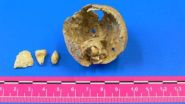(Press-News.org) DURHAM, N.H. – There's a well-known saying in New England that if you don't like the weather here, wait a minute. When it comes to independent voters, those weather changes can just as quickly shift beliefs about climate change.
New research from the University of New Hampshire finds that the climate change beliefs of independent voters are dramatically swayed by short-term weather conditions. The research was conducted by Lawrence Hamilton, professor of sociology and senior fellow at the Carsey Institute, and Mary Stampone, assistant professor of geography and the New Hampshire state climatologist. The research is presented in the article "Blowin' in the Wind: Short-Term Weather and Belief in Anthropogenic Climate Change" in the American Meteorological Society journal Weather, Climate, and Society.
"We find that over 10 surveys, Republicans and Democrats remain far apart and firm in their beliefs about climate change. Independents fall in between these extremes, but their beliefs appear weakly held — literally blowing in the wind. Interviewed on unseasonably warm days, independents tend to agree with the scientific consensus on human-caused climate change. On unseasonably cool days, they tend not to," Hamilton and Stampone say.
Hamilton and Stampone used statewide data from about 5,000 random-sample telephone interviews conducted on 99 days over two and a half years (2010 to 2012) by the Granite State Poll. They combined the survey data with temperature and precipitation indicators derived from New Hampshire's U.S. Historical Climatology Network (USHCN) station records. Survey respondents were asked whether they thought climate change is happening now, caused mainly by human activities. Alternatively, respondents could state that climate change is not happening, or that it is happening but mainly for natural reasons.
Unseasonably warm or cool temperatures on the interview day and previous day seemed to shift the odds of respondents believing that humans are changing the climate. However, when researchers broke these responses down by political affiliation (Democrat, Republican or independent), they found that temperature had a substantial effect on climate change views mainly among independent voters.
"Independent voters were less likely to believe that climate change was caused by humans on unseasonably cool days and more likely to believe that climate change was caused by humans on unseasonably warm days. The shift was dramatic. On the coolest days, belief in human-caused climate change dropped below 40 percent among independents. On the hottest days, it increased above 70 percent," Hamilton says.
New Hampshire's self-identified independents generally resemble their counterparts on a nationwide survey that asked the same questions, according to the researchers. Independents comprise 18 percent of the New Hampshire estimation sample, compared with 17 percent nationally. They are similar with respect to education, but slightly older, and more balanced with respect to gender.
In conducting their analysis, the researchers took into account other factors such as education, age, and sex. They also made adjustments for the seasons, and for random variation between surveys that might be caused by nontemperature events.
###
The University of New Hampshire, founded in 1866, is a world-class public research university with the feel of a New England liberal arts college. A land, sea, and space-grant university, UNH is the state's flagship public institution, enrolling 12,200 undergraduate and 2,300 graduate students.
GRAPHIC
http://www.unh.edu/news/img/hamilton_stampone_2013.jpg
Predicted probability of "climate change is happening now, caused mainly by human activities" response as a function of temperature anomaly and political party.
Credit: Lawrence Hamilton and Mary Stampone/UNH
A team of researchers led by the UAB has found the first ancient remains of a calcified ovarian teratoma, in the pelvis of the skeleton of a woman from the Roman era. The find confirms the presence in antiquity of this type of tumour - formed by the remains of tissues or organs, which are difficult to locate during the examination of ancient remains. Inside the small round mass, four teeth and a small piece of bone were found.
Teratomas are usually benign and contain remains of organic material, such as hair, teeth, bones and other tissues. There are no references in the ...
Though controversial, medical cannabis has been gaining ground as a valid therapy, offering relief to suffers of diseases such as cancer, Post-Traumatic Stress Disorder, ALS and more. The substance is known to soothe severe pain, increase the appetite, and ease insomnia where other common medications fail.
In 2009, Zach Klein, a graduate of Tel Aviv University's Department of Film and Television Studies, directed the documentary Prescribed Grass. Through the process, he developed an interest in the scientific research behind medical marijuana, and now, as a specialist ...
Michael Baum, Professor emeritus of surgery at University College London says that, while deaths from breast cancer may be avoided, any benefit will be more than outweighed by deaths due to the long term adverse effects of treatment.
He estimates that, for every 10, 000 women invited for screening, three to four breast cancer deaths are avoided at the cost of 2.72 to 9.25 deaths from the long term toxicity of radiotherapy.
These figures contrast with an independent report on breast cancer screening, led by Sir Michael Marmot and published in November last year. Marmot ...
The mosquitoes that spread dengue fever tap into the domestic networks of humans, along with their bloodstreams, finds a study recently published in the Proceedings of the National Academy of Sciences (PNAS).
The data from Iquitos, Peru, shows that the trail of the most rapid transmission of human infections does not lead through large, public gathering places, as might be expected, but from house-to-house, as people visit nearby friends and relatives.
"It's common in a dengue fever outbreak to first treat public places like schools for mosquitoes, but our results show ...
This press release is available in Spanish.
Biopesticides containing beneficial fungi are often grown on grains or other solids, but U.S. Department of Agriculture (USDA) scientists have shown a liquid diet can work better.
The approach, dubbed "liquid culture fermentation," offers several benefits, including lower material costs and increased yields of certain forms of insect-killing fungi, including Isaria or Metarhizium, which can serve as biobased alternatives to synthetic pesticides.
For decades, biopesticide makers have grown such fungi on moistened grains ...
In 1901 the star GK Persei gave off a powerful explosion that has not stopped growing and astonishing ever since. Now a team of Spanish and Estonian astronomers has reconstructed the journey of the emitted gas in 3D which, contrary to predictions, has hardly slowed down its speed of up to 1,000 km/s after all this time.
Thanks to the images captured from the Isaac Newton Telescope and the Nordic Optical Telescope in La Palma (Canary Islands, Spain), a European team of astronomers has constructed a three dimensional map of the remnant of a nova, or in other words, what ...
RUB researchers find altered connectivity in the brain network for body perception.
The weaker the connection, the greater the misjudgement of body shape
When people see pictures of bodies, a whole range of brain regions are active. This network is altered in women with anorexia nervosa. In a functional magnetic resonance imaging study, two regions that are important for the processing of body images were functionally more weakly connected in anorexic women than in healthy women. The stronger this "connection error" was, the more overweight the respondents considered ...
What to fear most if faced by a cancer diagnosis is the spread of the cancer to other parts of the body. This process called metastasis accounts for over 90% of cancer patient deaths and therefore is a strong focus for cancer researchers. Researchers at BRIC, University of Copenhagen have shown that the enzyme Lysyl Oxidase (LOX) can create a "scarred" microenvironment that enhances cancer spreading. By blocking activity of the LOX enzyme, the researchers succeeded in significantly decreasing metastasis in a model of breast cancer.
'When we inhibit the activity of LOX ...
HOUSTON – An engineered peptide provides a new prototype for killing an entire category of resistant bacteria by shredding and dissolving their double-layered membranes, which are thought to protect those microbes from antibiotics.
The synthetic peptide was effective in lab experiments against antibiotic-resistant Gram-negative bacteria, which cause a variety of difficult-to-treat, potentially lethal infections such as pneumonia and sepsis.
The team led by scientists at The University of Texas MD Anderson Cancer Center reported its findings online in advance of print ...
A study by health economists at the University of York has, for the first time, produced an estimate of the impact on other NHS patients of new and more costly drugs and other treatments.
This research suggests a refinement of the way the National Institute for Health and Clinical Excellence (NICE) gauges the cost-effectiveness of new interventions. It also has implications for the prices that the NHS can afford to pay for new drugs when the value-based pricing scheme for all new drugs is introduced by the Government in 2014.
The project was funded by the Medical Research ...

